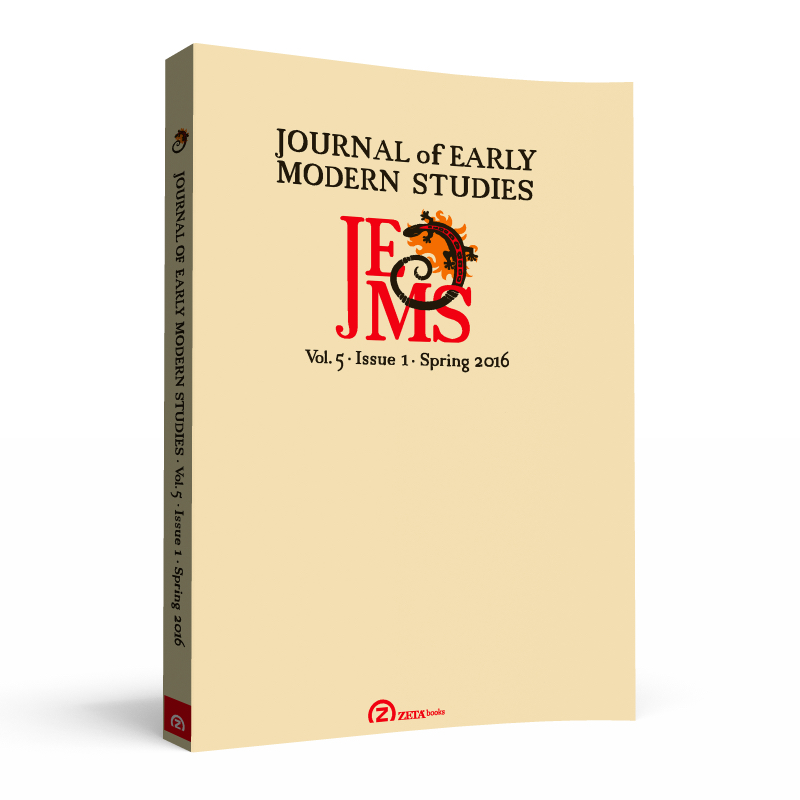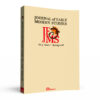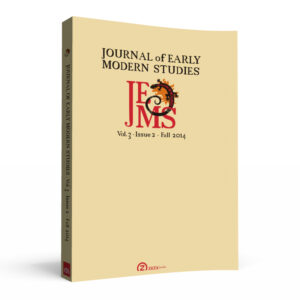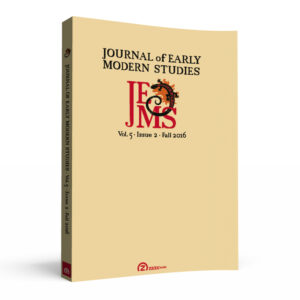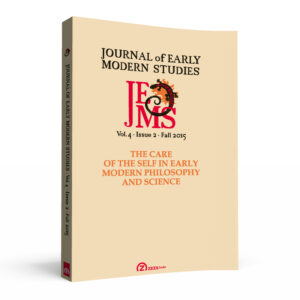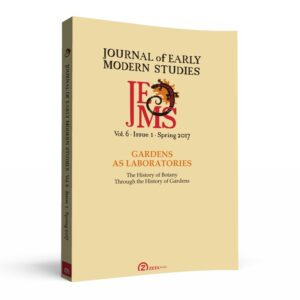ARTICLES
LUCA GUARIENTO (University of Glasgow), Life, Friends, and Associations of Robert Fludd: A Revised Account
- Abstract: In the last decades Robert Fludd’s philosophy has received increasing attention. On the other hand, his life, network, and acquaintances have been investigated in much less detail. As William Huffman rightly put it, “[o]ne of the main problems confronting someone interested in Robert Fludd is the lack of information about his formative years, as well as about his later associations”. Ron Heisler already observed that regrettably Huffman’s own account is not always accurate or complete. Scholars such as Johannes Rösche have recently added more details. The aim of this article is to give scope for further research; it collects contributions by previous scholars and adds details, corrects inaccuracies, identifies hitherto nameless (or misnamed) people with whom Fludd came into contact, and places he visited. It also takes into account current research coming from tangential fields, for instance studies on Fludd’s publisher or on philosophers such as Michael Maier, with whom he is thought to have been closely associated.
MINGJUN LU (University of Toronto), Implications of the New Modern Matter: A Monadic Approach to Milton’s Philosophy and Theology
- Abstract: This essay seeks to resolve three conceptual puzzles raised by Milton’sconception of the new modern matter. First, in both his epic poem Paradise Lost and theological treatise The Christian Doctrine, Milton depicts a motive and generative matter and regards it as the substantial principle that produces all manners of life. Meanwhile, he also represents God as the primary fountain of beings. The priority of the primal matter seems to directly challenge the putative primacy of the divine deity. Second, in conceiving of the substantial principle as both good matter and wild chaos, Milton appears to posit two kinds of primary matter, which runs counter to his allegedly monistic outlook. Third, Milton’s monism seems to contradict his apparent distinction between corporeal and spiritual beings as well. The ancient philosophy of the monad as reformulated by Giordano Bruno and developed by the Conway Circle, I argue, provides a pertinent framework for Milton to negotiate the theological implications of the new matter. The monadic model can account for at once the tensions between Milton’s substantial and theological principles of unity, between his good matter and wild chaos, and between his monistic vision and images of corporeal and incorporeal beings.
KEITH GREEN (East Tennessee State University), Forgiveness, Pardon, and Punishment in Spinoza’s Ethical Theory and “True Religion”
- Abstract: Spinoza shares with almost all apologists for forgiveness the idea that laying down one’s resentment of a wrong, contempt for a wrongdoer, and overcoming “bondage” to hatred, must be a primary ethical aim. Yet he denies that doing so authorizes pardoning a penitent wrongdoer. He argues that in civil society, it is actually a matter of charity and piety to collude in punishing a wrongdoer— dragging the wrongdoer before a judge, but not “judging” him oneself. I argue that Spinoza offers no warrant to pardon whatever for those not authorized under civil law to punish. But I argue that the response to others’ hatred and deceit that Spinoza urges his reader to cultivate in Ethics 5p10, along with his argument that one may ‘turn the other cheek’ under conditions of oppression, where no sovereign power prosecutes claims of justice, mandates a broader emergent and reparative view of forgiveness.
SEAN WINKLER (Katholieke Universiteit Leuven), The Problem of Generation and Destruction in Spinoza’s System
- Abstract: In this paper, I address the problem of generation and destruction in Spinoza’s philosophical system. I approach this problem by providing an account of how Spinoza can maintain that contrary finite modes cannot inhere in the same substance, while substance itself does not change. One must distinguish between the formal essence of a mode and the existence of a mode and how these two entities are “in” substance. Formal essences are eternal and are in substance in a Platonic sense, while existent modes are temporal and are in substance insofar as they are parts of the whole of nature, or facies totius universi (face of the universe). Furthermore, the former are modes understood as pure relations, while the latter are modes understood as finite individuals. Formal essences are relations that specify how finite individuals will behave once they come into existence, while existent modes are individuals that express the relations defined by formal essences, as forces that possess a capacity to act and to be acted upon. According to these distinctions, I maintain that it is possible to develop a coherent account of contrariety and, consequently, of generation and destruction in Spinoza’s system.
TZUCHIEN THO (University of Bucharest), Actual and Ideal Infinitesimals in Leibniz’s Specimen Dynamicum
- Abstract: This article aims to treat the question of the reality of Leibniz’s infinitesimals from the perspective of their application in his account of corporeal motion. Rather than beginning with logical foundations or mathematical methodology, I analyze Leibniz’s use of an allegedly “instantiated” infinitesimal magnitude in his treatment of dead force in the Specimen Dynamicum. In this analysis, I critique the interpretive strategy that uses the Leibnizian distinction, drawn from the often-cited 1706 letter to De Volder, between actual and ideal for understanding the meaning of Leibniz’s infinitesimal fictionalism. In particular, I demonstrate the ambiguity that results from sticking too closely with the idea that ideal mathematical terms merely “represent” concrete or actual things. In turn, I suggest that, rather than something that had to be prudentially separated from the realm of actual things, the mathematics of infinitesimals was part of how Leibniz conceived of the distinction between the actual and ideal within the Specimen Dynamicum.
EMANUELE COSTA (University of London), Leibniz on Relations: From (Soft) Reductionism to the Expression of the Universe
- Abstract: In this paper, I undertake an analysis of Leibniz’s theory of relations. My main argument focuses on distinguishing the ontological part of this theory from the logical/grammatical part, and showing that several studies of this subject are misplaced. I offer a clarification of the matter, presenting an argument that shows how Leibniz does not provide a unified theory for the two sides of his theory of relations. I proceed to argue about soft and hard reductionism, supporting the former. I show how Leibniz’s “re-writing project” about the elimination of dyadic predicates in the “perfect language” of philosophy fits in the picture of his theory without the implication of a nominalist position. Nevertheless, thanks to the distinguishing argument, I am able to argue for Leibniz’s conceptualism on the ontological side of the theory of relations, without using any logical/grammatical argument. I deploy an analysis of all the core themes in his theory, from compossibility to expressionism, from concogitabilitas to supervenience, showing how Leibniz’s position is neither nominalist nor realist, but rather a medial position that has to be understood in its own complexity.
REVIEW ARTICLE
SOPHIE ROUX (École Normale Supérieure), Everything You Always Wanted to Know About the Summa quadripartita that Descartes Never Wrote
BOOK REVIEWS
ANNA AKASOY and GUIDO GIGLIONI (eds.), Renaissance Averroism and Its Aftermath: Arabic Philosophy in Early Modern Europe, Dordrecht: Springer, 2013 (Lucian Petrescu)
PHILIP BEELEY and CHRISTOPH J. SCRIBA (eds.), The Correspondence of John Wallis, Oxford: Oxford University Press, vol. III 2012; vol IV, 2014 (Iordan Avramov)
ISSN: 2285-6382 (paperback)
ISSN: 2286–0290 (electronic)
ISBN: 978-606-697-028-0 (paperback)
ISBN: 978-606-697-029-7 (electronic)
The publication of this issue was supported by three grants of the Romanian National Authority for Scientific Research, CNCS-UEFISCDI, project numbers: PN-II-ID-PCE-2011-3-0998: Models of Producing and Disseminating Knowledge in Early Modern Europe: the Cartesian Framework; PN-II-RU-TE-2014-4-1776: An Intellectual History of the Imagination: Bridging Literature, Philosophy and Science in Early Modern and Enlightenment England; PN-II-RU-TE-2014-4-2522: Philosophy between Mathematical Method and Experiment: the Berlin Academy (1746-1764).

